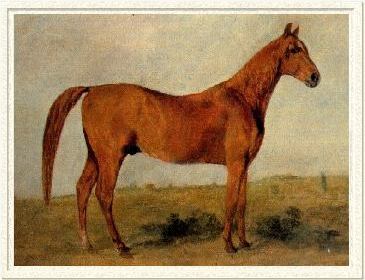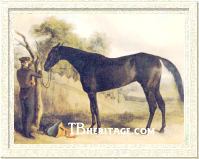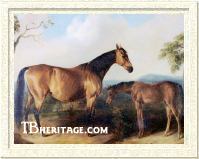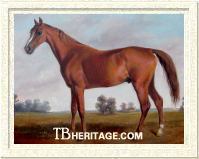|
|
American Eclipse

|
|
 |
|
|
American Eclipse was bred by General Nathaniel Coles of Queens County, Long Island, New York. Foaled on May 25, 1814, his dam, Miller's Damsel, was described by turf historian John Hervey as "the Queen of the Northern Turf" during her racing days. She was a daughter of imported Messenger, a sire more famous for his influence on the Standardbred breed. Eclipse's sire was Duroc, next to Sir Archy, one of the best sons of imported Diomed. Eclipse, named for the great English racehorse of the mid-1700's, was put into training at three, made an impressive trial that year, then turned out to mature. He raced for the first time as a four-year-old (in 1818), defeating Black-Eyed Susan and Sea Gull in three mile heats for a $300 purse at New York's Newmarket course at Hempstead.
Eclipse was purchased by Cornelius W. Van Ranst on March 15, 1819 for $3,000 and opened his five-year-old season with a victory over Little John, Bond's Eclpse, and James Fitzjames in four mile heats, and closed it with a similar venture in October of the same year, with Little John again falling as his hapless victim, both races with a $500 purse.
With nothing left to prove, Van Ranst retired him to stud as a six-year-old, covering mares for a fee of $12.50. Into his second season at stud, clamor for his return as the North's champion was so great that Van Ranst put him back into training, in addition to serving 87 mares. He returned in time for one race that season, over four mile heats for $500 at the new Union Course on Long Island. It was opening day, and the runners competed on the new "skinned" surface, thus introducing America's version of "dirt racing." After winning the first heat, trouncing Lady Lightfoot, Flag of Truce, and Heart of Oak, Eclipse scared away all but Lady Lightfoot, who was distanced, in the second heat. Back in peak form, he returned at eight to remain undefeated in three more races. In the spring, he bested the good horse Sir Walter at four mile heats for the $700 purse. He returned in the fall to again face Sir Walter for $1,000. Eclipse took the first heat against Sir Walter, Duchess of Marlborough and Slow and Easy, and in the second heat, only Sir Walter went postward against him, and sulked, allowing Eclipse to win without the slightest exertion.
A great North-South match was arranged with Van Ranst's Eclipse representing the North and James J. Harrison's Sir Charles, a Virginia-bred son of Sir Archy, representing the South. The match was arranged at $5,000 a side, over four mile heats at the Washington D. C. course that November. Days from the race, Sir Charles rapped a tendon and was forced to forfeit. A rematch was called, equally as unsatisfying, as Sir Charles broke down in the final mile, leaving Eclipse the victor.
Eclipse stayed in training as a nine-year-old and defended his championship in May (1823), in a high-stakes event at the Union Course. The conditions were $20,000 put up on either side (North-South), $3,000 to forfeit, Eclipse to run against the best horse from the South, which turned out to be Lemuel Long's Henry (Sir Henry), a four-year-old chestnut son of Sir Archy. The race attracted a crowd of 60,000, making it a landmark in sports history, the biggest sporting event ever witnessed. Shockingly, Henry defeated Eclipse (the first horse to ever do so) by a length in the first heat in a new record time of 7 minutes 37 seconds for four miles. The victory wasn't the sweetest, since Eclipse, carrying 126 pounds, was giving away 16 pounds to his five years younger rival, who carried 108. Eclipse was also said to be the victim of a bad ride and his jockey, William Craft whose cruel use of the whip left a cut on the stallion's testicle, was set down for the next heat, to be replaced by Purdy. Duroc's brave son duly won and evened the score, then came back in the third heat to win by three lengths against a valiant Henry.
American Eclipse in the Stud
Eclipse finally got the reward he deserved, final retirement to stud, after an undefeated racing career that spanned five seasons, eight victories and earnings of $25,000. He entered stud in 1824 at John Snedeker's farm in New York state, commanding a stud fee of $75.00 and $100.00. While standing in New York, he sired Medoc, an outstanding racehorse and later an important sire. Offered at auction after a few seasons, American Eclipse began a lengthy road trip that was to last almost to the end of his days.
|

Black Maria

Bay Maria

Shark

Goliah
| |
He was purchased by Walter Livingstone for $8,050 and continue standing in New York State. In 1833, he was purchased by James J. Harrison of Virginia to replace his old rival, the leading sire Sir Charles, who had died that same year. Over the next few seasons he stood at various locations including Boydton, Virginia and Baltimore, Maryland before being sold to Kentucky in 1837.
In 1839 and 1840 Eclipse stood in Tennessee at James Swanson's Stable, Independence, near Franklin, Williamson County for a fee of $100. In 1841, he found himself at A. Whitlock's stud in Limestone County, Alabama. He returned to Kentucky to stand at Colonel Edward M. Blackburn's Farm in Woodford County, and died at the advanced age of 34, at the farm of .... in Shelby County Kentucky on July 10, 1847.
Although never a leading sire like his rival Sir Charles, or his son, MEDOC, Eclipse proved outstanding and influential. His best runner was MEDOC (ch.c. 1829 out of Young Maid of the Oaks by Expedition), a champion runner and America's Leading Sire in 1840 and 1841. He also sired two outstanding fillies, Ariel (gr.f. 1822 out of Young Empress by Financier), winner of 42 races in 57 starts; and BLACK MARIA (bl.f. 1826 out of Lady Lightfoot by Sir Archy) who defeated another daughter of Eclipse, the southern champion TRIFLE (f. out of.... ) in famous match race at the Union Course in 1832.
Eclipse's other top runners included MINGO, GOLIAH, LANCE, SHARK, MONMOUTH ECLIPSE, FANNY RICHARDS, PAUL CLIFFORD, FORWARD, and BAY MARIA. GOLIAH'S (1827) wins included the Jockey Club purse at the Fairfield Course in Virginia, "the severest and most splendid race of modern times in the vicinity of Richmond," held in four mile heats.
Besides twice leading sire MEDOC, American Eclipse also sired the stallion BRAWNER'S ECLIPSE, whose daughter Nantura (dam by Henry) produced the great champion Longfellow.
Another daughter, LIZE, became the second dam of Enquirer (by Leamington), while GLORIANA produced Jack Malone and Pat Malloy, both sire sons of Lexington. GIPSY (a sister to MEDOC) produced Pryor and the famous Sister to Pryor. An unnamed daughter produced Mattie Gross (by Lexington). Other daughters that appear in pedigrees include MISS PEYTON, LADY THOMKINS, MARIA DOWNING, and ANN INNIS.
|
Several portraits exist of American Eclipse, thanks to his number one fan, Charles Henry Hall of the Harlem Stud in New York. Hall, who bred BLACK MARIA, commissioned Alvan Fisher (1792-1863) to paint several portraits of the great champion. The image that accompanies this article is the famous portrait by Edward Troye that hangs in the National Sporting Library in Middleburg, Virginia. It shows American Eclipse as an attractive, well-made, lengthy chestnut with a star on the forehead and his left hind ankle white. He was said to stand 15.1 hands, with good bone. His speed, durability and courage were never questioned; his adaptability and hickory constitution proven over many years at stud. In every sense, he lived up to his namesake, as America's Eclipse.
-- Anne Peters |
|
|
|

